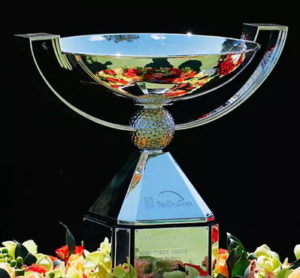Fed-Ex Cup Betting Offers 2024
 In the world of golf, it sometimes feels as though there are the Majors and then everything else. The British Open, US Open, PGA Championship and the Masters are the tournaments that all golfers dream of winning and all fans of the sport want to watch, but away from the glory trophies are are number of events that players are keen to win and the FedEx Cup is one of them. It may not have the appeal of the likes of the Ryder Cup, but there’s enough cachet to ensure that golfers are delighted when they are declared the winners.
In the world of golf, it sometimes feels as though there are the Majors and then everything else. The British Open, US Open, PGA Championship and the Masters are the tournaments that all golfers dream of winning and all fans of the sport want to watch, but away from the glory trophies are are number of events that players are keen to win and the FedEx Cup is one of them. It may not have the appeal of the likes of the Ryder Cup, but there’s enough cachet to ensure that golfers are delighted when they are declared the winners.
For those watching with a casual interest rather than a professional one, the FedEx Cup is intriguing because it offers a different format to most golf tournaments. It was the first to introduce the idea of play-offs to the sport, for example, with players earning the right to be part of the competition’s leader board throughout the PGA Tour season.
Players earn FedEx Cup points depending on how well they do in 40+ PGA Tour events, with the best players entering the play-offs at the end of the season. Given that the winner takes away a $18 million bonus prize and an exemption from the need to qualify for the PGA Tour for 5 years, it’s well worth winning.
FedEx Cup Betting Offers for 2024
This event has not started yet, please check back nearer the time. For other offers see our main loyalty page.
2024 Qualifying and Play-Offs
| Event | Location | Date | Players Entering | Player Qualify |
|---|---|---|---|---|
| St. Jude Championship | Tennessee | 15-18 August | 125 (+ties) | 70 (+ ties) |
| BMW Championship | Maryland | 22-25 August | 70 | 30 |
| Tour Championship | Georgia | 29August – 1 September | 30 | – |
In order to qualify for the play-offs, golfers have to end the regular season within the top 125 places on the FedEx Cup standings after the Wyndham Championship. The one thing to bear in mind is that ties also qualify, so if 10 players end up tied for 125th then they’ll all make it into the tournament.
Just because players have made it into the first play-off doesn’t mean that they’ll make it through all of them, though. The top 70 players (including ties) at the conclusion of the St. Jude Championship (previously named the Northern Championship) event move into the BMW Championship. The Dell Technologies Championship used to follow the St. Jude Championship as a play-off event but this was removed from 2019 onwards, reducing to three play-off events.
If players are hoping to make it to the 3rd and final event, the Tour Championship, then they’ll need to finish in the top 30 of the BMW Championship.
Racking Up Play-Off Points
 From the moment the first event of the PGA season begins, which is normally in October of the year before, players can earn points by doing well in each of the events that they play in throughout the year.
From the moment the first event of the PGA season begins, which is normally in October of the year before, players can earn points by doing well in each of the events that they play in throughout the year.
What makes things interesting is that different numbers of FedEx points are awarded depending on the event:
- First place in official PGA Tour event – 500
- Four Majors + Players Championship – 600
- World Golf Championships – 550
- Additional Events – 300
The typical number of points that are awarded in any given tournament are 500, with the amount of points you’re awarded dropping the further away from 1st that you finish. For example, for a PGA tour event second place would earn 300 points, 190 for third, 135 fourth, etc.
Only players that are considered to be regular and full-time members of the PGA Tour can earn points, with non-members who join the tour midway through only being eligible to earn points after the first event since they officially joined.
How The Play-Offs Worked Previously
 When the regular season comes to an end, the players in the top 125 positions move forward to play in the Northern Trust event, which is the first of the play-offs. They take the number of points they earned throughout the season into the play-offs with them, gaining another 2,000 if they win it.
When the regular season comes to an end, the players in the top 125 positions move forward to play in the Northern Trust event, which is the first of the play-offs. They take the number of points they earned throughout the season into the play-offs with them, gaining another 2,000 if they win it.
Those points are added together and the top 70 players move into the second play-off event. As mentioned earlier, the number of players that are able to advance to the next play-off event is reduced each time until just 30 move forward to play in the Tour Championship.
At this point, the accumulated points used to be reset so that the player in 1st has 2,000, 2nd has 1800 and so on, all the way down the the player in 30th who had 168 points. Realistically, only the top 5 players had a chance of winning the FedEx Cup by being victorious in the Tour Championship.
Play-Off Changes From 2018-2019 Season

Ahead of the 2018-2019 PGA season the organisers of the Tour consulted with an expert from MIT in order to come up with a system that was fairer for all.
The old system meant that if you won the Tour Championship then you were pretty much guaranteed to win the FedEx Cup as well, such was the point differential between the top five players and everyone else.
The rules introduced for the 2018-2019 season mean that points will no longer be reset and instead players will begin the Tour Championship with a deficit on their score card. It works as follows:
- 1st, -10
- 2nd, -8
- 3rd, -7
- 4th, -6
- 5th, -5
- 6th to 10th, -4
- 11th to 15th, -3
- 16th to 20th, -2
- 21st to 25th, -1
- 26th to 30th, 0
The hope is that the most consistent players over the course of the season will be rewarded for their consistent play. There was also a situation in 2017 when Xander Schauffele won the Tour Championship but Justin Thomas won the FedEX Cup, which organisers are hoping will not happen again with the new system.
What’s interesting is that a computer simulation was run of all previously FedEx Cups with the new scoring system in place in order to find out what would have happened. The result of the simulation was that the same player would have won on all but two occasions. In 2010 Jim Furyk and Luke Donald would’ve ended up in a play-off at the end of the Tour Championship, with Donald winning outright in 2011 instead of the actual winner Bill Haas.
With that in mind, then, it really begs the question: what’s the point in the new system? After all, if all of the same players would’ve won bar two is it really worth changing the current method?
Justin Rose, the 2018 winner, felt that the change would reduce confusion for those watching at home. He said that it seemed as though the original plan was for there to be just one trophy to be played for on the Sunday of the Tour Championship, rather than the Tour Championship and the FedEx Cup as two distinct trophies, and that this would ‘simplify everything’.
The biggest change of all for the 2018-2019 season is the fact that there are just three play-off events rather than four. 125 players will compete for the Northern Trust, but the Dell Technologies Championship has been cut out of the running altogether. Instead, the top 70 take part in the BMW Championship and then the top 30 move into the Tour Championship as usual.
How The Prize Money Works

The confusing thing about the FedEx Cup is that the event is technically season-long, meaning that players can earn money throughout the year.
The final event of the regular season, for example, is the Wyndham Championship and the organisers also made changes to how its run ahead of the 2018-2019 season. The top 10 players on the FedEx Cup leaderboard at the conclusion of the Wyndham will collect bonuses ranging from $4 million for the winners down to $1 million for the player that comes 10th.
In terms of the FedEx Cup itself, though, the bonus pool was given a large shot in the arm ahead of 2018-2019. The total amount was increased by $25 million to $60 million, whilst the winner’s share of that increased from $10 million to $15 million. In 2022 that was increased again, partly due to the new LIV Golf Tour threat, to $18 million for the winner out of $75 million overall.
It’s interesting to note that when the FedEX Cup first began the money wasn’t given as a straight cash payment. Instead, winnings were entered into a tax-deferred retirement account that players could either start to receive after they turned 45 or else defer again until they turned 60.
That changed in 2008, at which point the top 10 players received the majority of their winnings in cash with only a small amount going into a retirement fund. That year, for example, the winning golfer was paid $9 million and had $1 million entered into his retirement fund.
What Do FedEx Winners Get
 Players that win the Fed-Ex Cup get $18,000,000 in cool cash. They also receive a 5 year exemption from needing to qualify to be on the PGA Tour, receiving automatic entry.
Players that win the Fed-Ex Cup get $18,000,000 in cool cash. They also receive a 5 year exemption from needing to qualify to be on the PGA Tour, receiving automatic entry.
Players that win the Tour Championship from 2019 no longer receive additional prize money for winning the event. They still however win $3.60 million dollars in prize money as winners of the St. Jude Championship and BMW Championship event respectively.
One fun little additional prize that the get, in addition to being crowned the FedEx Cup winner, is the Calamity Jane Trophy. Calamity Jane was the name given to Bobby Jones’s putter and Tour Championship winners get an exact replica of it. That tradition was introduced in 2005, with all former winners retrospectively awarded one.
Previous FedEx Cup Winners
| Year | Winner | Points | Victory Margin | Tour Champ Winner |
|---|---|---|---|---|
| 2024 | – | – | – | – |
| 2023 | Viktor Hovland | -27 | 5 stokes | Viktor Hovland |
| 2022 | Rory McIlroy | -21 | 1 stokes | Rory McIlroy |
| 2021 | Patrick Cantlay | -21 | 1 stokes | Patrick Cantlay |
| 2020 | Dustin Johnson | -21 | 3 stokes | Dustin Johnson |
| 2019 | Rory McIlroy | -18* | 4 stokes | Rory McIlroy |
| 2018 | Justin Rose | 2260 | 41 | Tiger Woods |
| 2017 | Justin Thomas | 3000 | 660 | Xander Schauffele |
| 2016 | Rory McIlroy | 3120 | 740 | Rory McIlroy |
| 2015 | Jordan Spieth | 3800 | 1493 | Jordan Spieth |
| 2014 | Billy Horschel | 4750 | 1650 | Billy Horschel |
| 2013 | Henrick Stenson | 4750 | 2007 | Henrick Stenson |
| 2012 | Brandt Snedeker | 4100 | 1273 | Brandt Snedeker |
| 2011 | Bill Haas | 2760 | 15 | Bill Haas |
| 2010 | Jim Furyk | 2980 | 252 | Jim Furyk |
| 2009 | Tiger Woods | 2980 | 11080 | Phil Mickelson |
| 2008 | Vijay Singh | 125101 | 551 | Camilo Villegas |
| 2007 | Tiger Woods | 123033 | 12578 | Tiger Woods |
* From 2019 the scores are reset prior to the Tour Championship with players in the top 10 for points given a stroke advantage, see format changes section for more detail.
Tour Championship – East Lake Golf Course
 Between 1987 and 1996 a series of golf courses were used to host the Tour Championship, which is the final event on the PGA Tour and the last play-off match of the FedEx Cup.
Between 1987 and 1996 a series of golf courses were used to host the Tour Championship, which is the final event on the PGA Tour and the last play-off match of the FedEx Cup.
In 1997 it was decided that Houston’s Champions Golf Club and East Lake Golf Club in Atlanta would share hosting duties, then in 2004 the event began to call East Lake its permanent home.
The private course sits 5 miles east of Atlanta in the state of Georgia was established back in 1904, making it the oldest golf course in the city. It was the home course of Bobby Jones, who was an amateur golfer best-known for helping to design Augusta National and being one of the driving forces behind the Masters. As a result, much of the course and clubhouse is dedicated to his life.
The decision to create the course in the first place was taken because Atlanta Athletic Club proved to be a popular one, with 700 people joining it within its first 4 years of existence. The club bought property at East Lake and decided to build a country club with a golf course designed by Tom Bendelow.
The first holes weren’t built until 1906, expanding to an 18-hole course the following year. A 2nd course was opened in 1908, initially just a 9-hole one that was redesigned in 1928 by Donald Ross.
In the 1960s the course came close to closing altogether, with the Atlanta Athletic Club selling the No. 2 course and moved its base to Johns Creek. The original course as well as the clubhouse were both saved by a group of members who bought them in 1968. As the 1960s became the 1970s the Atlanta area deteriorated with each passing year. By the start of the 1980s East Lake was little more than a forgotten golf course that was once the home of Bobby Jones.
It wasn’t until 1993 that the course began to be seen in a new light, thanks in no small part to the fact that it was purchased by a local charitable foundation that wanted to make it a tribute to Jones. The East Lake Foundation was created, becoming a source of funding for the regeneration of the local area. This saw a complete turnaround of fortunes for the course, including the restoration of Donald Ross’s original layout by Rees Jones in 1994. The turnaround was completed in 1998 when the Tour Championship was held at the course for the first time.
Any profits made by East Lake Golf Course are given over to the East Lake Foundation, leading to it having the motto of ‘Golf with a Purpose’. Purpose Built Communities, a non-profit organisation, was created in 2009 using the East Lake model as its basis. It helps poverty stricken community throughout the United States and by the end of 2018 could be found in 14 cities.
The History Of The FedEx Cup

The FedEx Cup is one of the youngest major competitions in golf, having only been founded in 2007. Since then it has undergone numerous changes to format as the PGA does its best to fine-tune one of its showpiece events.
It was announced that a new competition would be being launched in November of 2005, with the first outing of it coming 2 years later. The name of the competition comes from the fact that it is sponsored by the delivery company FedEx.
The idea behind the FedEx Cup was to give something extra for players to play for throughout the season, seeing them earn points every time they took part in a PGA-run event. Unlike the Masters, the FedEx Cup was to be a season-long competition with a large amount of prize money ($35 million in bonus money and $32 million in play-ooff prize money) up for grabs.
There isn’t much more to tell you about the origins of the Cup, with the manner in which it has changed over the years being the most important bit of its history.
The First Set Of Rule Changes
 Whilst the PGA were happy enough with their new tournament back in 2007, they realised that it wasn’t perfect and wanted to move to add improvements to the scoring methods and so on. That’s why the two sets of rule changes were introduced in the two years that followed the tournament’s introduction to the tour.
Whilst the PGA were happy enough with their new tournament back in 2007, they realised that it wasn’t perfect and wanted to move to add improvements to the scoring methods and so on. That’s why the two sets of rule changes were introduced in the two years that followed the tournament’s introduction to the tour.
At the start of 2008 alterations were made in order to allow golfers a better chance of improving their position on the leaderboard once the play-off phase was underway. More points were available, for starters, and the manner in which points were reset was tightened slightly. The idea was to allow some form of punishment for players who had skipped a play-off event for some reason.
In November of the same year, changes were made after Vijay Singh had already won enough points in the first 3 play-offs to make to ensure that he’d win the FedEx Cup regardless of what happened in the final event. As a result, changes were made to stop a winner from being decided until all golfers that had qualified for the event had finished playing in it.
An alteration to how things worked on the PGA Tour occurred in 2013 when FedEx Cup points were allowed to determine which golfers would gain their ‘tour cards’ and be allowed to play on the PGA Tour again the following year. Prior to that the places for the 125 golfers were determined by where about on the money list they found themselves at the end of the year.
Records and Stats
 As of 2023, there are a number of interesting records surrounding the FedEx Cup. Here’s the best of them:
As of 2023, there are a number of interesting records surrounding the FedEx Cup. Here’s the best of them:
- More Americans have won the play-offs than players from any other nation, with 39 play-off wins in total to their name compared to the 4 for Australia and 6 for Northern Ireland
- Tiger Woods has earned more FedEx Cup points and money than any other player
- Rory McIlroy is the leading earner having won £50,444,000 in FedEx bonus money
- Tiger Woods and Rory McIlroy are the only players so far to win the FedEx Cup more than once, Tiger with two wins in 2007 & 2009 and McIlroy with a record three wins (2016, 2019 & 2022).
- Woods and McIlroy also hold the record for most Tour Championship wins with 3 each.



